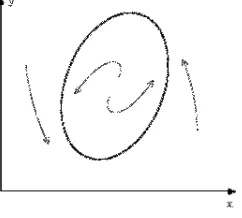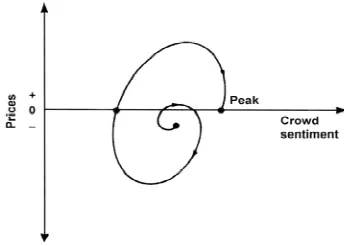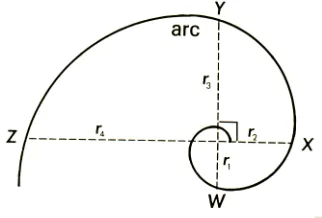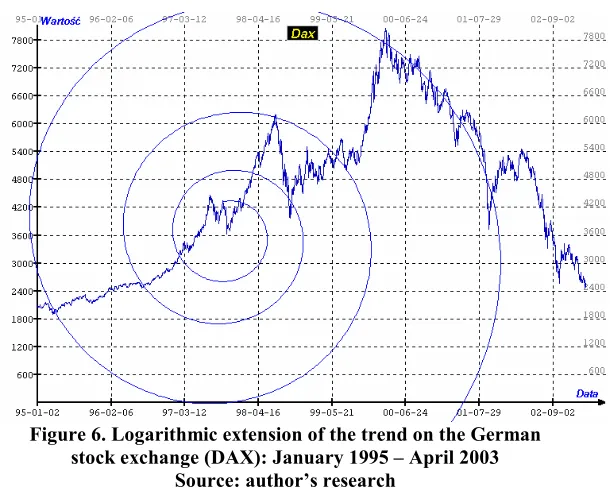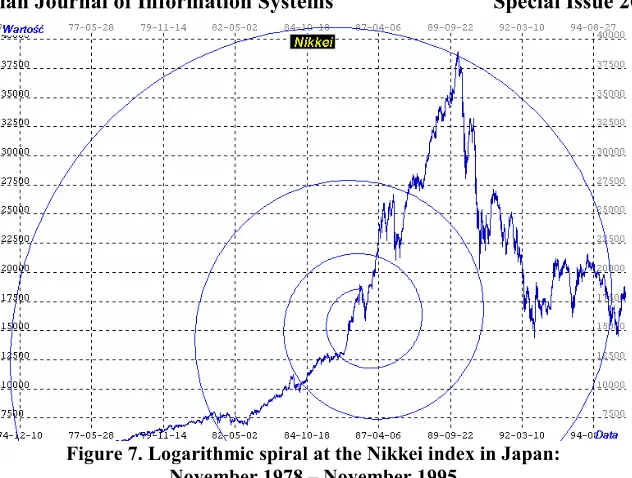MODELING THE DYNAMICS OF AN INFORMATION SYSTEM
Jacek Unold
The Wroclaw University of Economics Komandorska 118/120
53-345 Wroclaw Poland
unold@han.ae.wroc.pl
ABSTRACT
The article concentrates on the nature of a social subsystem of an information system. It analyzes the nature of information processes of collectivity within an IS and introduces a model of IS dynamics. The model is based on the assumption that a social subsystem of an information system works as a nonlinear dynamic system. The model of IS dynamics is verified on the indexes of the stock market. It arises from the basic assumption of the technical analysis of the markets, that is, the index chart reflects the play of demand and supply, which in turn represents the crowd sentiment on the market.
INTRODUCTION
The area of information systems (IS) is often seen to be about technology. However, this area is multidisciplinary and although information technology (IT) is certainly relevant, so are human and organizational aspects (e.g., Vidgen et al., 2002). All information systems, from manual to informal to computer-based, are designed, operated and used by people in a variety of organizational and environmental settings and contexts. The ubiquitous processes of globalization and virtualization are constantly changing our understanding of the human factor involved in the operation of information systems. No longer can we perceive the “people” component of IS as independent individuals. The users of local, regional and global telecommunication networks create a specific form of a “virtual crowd”, accessing the same sources of information and reacting to the same sets of stimuli. This phenomenon creates a new challenge and defines new research areas.
The article concentrates on the nature of a social component of an information system, a component determining the IS dynamics. It proposes an innovative approach to the analysis and modeling of collective information processes and mechanisms of collective behavior. This is the first attempt of this kind in relation to the above-mentioned social issues in the IS area. The following research question has been formulated against the background of the state-of-the-art:
• Are information processes of collectivity and the resulting collective behavior, which make the IS dynamics, phenomena of exclusively qualitative nature, impossible to structure? To answer this question a model of IS dynamics is introduced. The model is based on the assumption that a social subsystem of an IS works as a nonlinear dynamic system.
Generally, the adopted research methodology consists of the following stages: identification, analysis, synthesis, exemplification, verification, and interpretation. The structure of the presentation helps illustrate the modeling process. In the following chapters the article introduces the notion of a social subsystem within an information system, identifies determinants of the IS dynamics, analyzes the phenomenon of self-organization of collective behavior within an IS, synthesizes the research findings in a model representation of the IS dynamics, and presents its exemplification, verification, and interpretation.
SOCIAL COMPONENT OF AN INFORMATION SYSTEM
processes and delivers information relevant to an organization (or to society), in such a way that the information is accessible and useful to those who wish to use it, including managers, staff, clients and citizens. The authors stress that an information system is a human activity (social) system, which may or may not involve the use of computer systems. This definition is very useful in that it emphasizes the human and organizational aspects of information systems, and makes clear that not all information systems use IT. The area of IS might include simple manual (paper-and-pencil) information systems, informal (word-of-mouth) information systems or computer-based information systems.
Despite slightly different approaches and definitions, people are required for the operation of all information systems. This is the social component of all information systems. Avison and Fitzgerald (2003, p. 5, 6) outline two examples of an IS, at somewhat different ends of the spectrum. One is a payroll system, which was one of the first applications to be computerized. The other example system is very different. It is an electronic auction house, such as eBay. It is relatively new (eBay started in 1995) and exciting, and uses the World Wide Web as its user interface. Yet, essentially, it is just an information system. It matches buyers with sellers utilizing an auction concept. The electronic auction enables buyers and sellers to be geographically distributed across the world. The electronic auction is an IS, comprising people, rules, procedures, technology, software, communications and allied services. Such electronic houses reflect the shift from marketplace to marketspace in modern business environment. Exactly the same understanding of an IS can be applied to a modern electronic and virtual stock exchange, where people, distributed geographically, can perform market transactions via telecommunications technologies. Thus, a social subsystem of a stock exchange IS is a chosen research area for this analysis.
COLLECTIVE BEHAVIOR AND IS DYNAMICS
The next concept, which has to be discussed is that of dynamics and IS dynamics. One of the meanings of the word dynamics (gr. dynamikos – strong, forceful) refers to the motivating or driving forces, physical or moral, in any field (Webster’s, 2002; p. 445). By the dynamics of an organization we understand the dynamics of its information system, considering the subjectivity and crucial role of its social subsystem. Such a notion of dynamics represents changes in the various types of knowledge, in the learning, and unlearning processes (Eden and Spender, 1998; p. 15). In this approach, the basic determinants of the IS dynamics are: knowledge, learning and unlearning. The research shows that collective knowledge cannot be understood without paying attention to the communication processes going on among the group’s members (Weick and Roberts, 1993; p. 358). It follows that information processes of collectivity are another determinant of the IS dynamics, and learning and unlearning processes constitute a specific category of those processes.
According to Turniansky and Hare (1998; p. 112), organizational learning is a metaphor to focus attention on the ways an organization adapts to its environment. Organizational learning occurs when knowledge, acquired and developed by individual members, is embedded in “organizational memory”. This process can be identified at four levels of learning: individuals, groups, organizations, and populations of organizations. Cook and Yanow (1993) present “a cultural perspective” of organizational learning, which is understood as the acquiring, sustaining, or changing of intersubjective meanings through the collective actions of the group. This concept directly refers to the generic notion of dynamics, understood as the ability to act. Hence, collective behavior is the next determinant of the IS dynamics.
development of collective mind. Many authors use the notions of collective mind and organizational culture interchangeably (Eden and Spender, 1998).
The notion of collective mind offers a means to contemplate organizational intelligence. It is interesting that an organism (system) does not even need a brain in order to be intelligent. Intelligence is a property that emerges when a certain level of organization is reached, which enables the system to process the information (Wheatley, 1999; p. 98).
The concepts of collective mind and organizational intelligence add a crucial qualitative dimension to the systems analysis. They add the missing internal social dimension to the technical or mechanistic dimension, which is the focus of classical theory of systems and organizations. These concepts also allow for further analysis of the IS dynamics, which is understood as a phenomenon directly linked with collective behavior within “a human activity (social) system,” in another words, within an information system.
SELF-ORGANIZATION OF COLLECTIVE BEHAVIOR IN IS
To identify the basic characterstics of a social subsystem of an IS it is helpful to analyze the issue of alternative organizational forms. Contemporary literature points to four basic forms (Turniansky and Hare, 1998; p. 101):
• the bureaucratic organization,
• the post-bureaucratic, interactive organization, • team-based organization,
• self-organization.
The fourth category, self-organization, is especially important for further analysis. The challenges of the future – globalization and virtualization of business activity – are indicating that organizations will probably have to move much closer to the model of a complex adaptive system. Some of the characteristics of complex adaptive systems (Freedman, 1992), which are relevant to this discussion include:
a) they consist of a network of agents acting in a self-managed way without centralized control;
b) the environment in which the agents find themselves is constantly changing and evolving since it is produced by their interactions with other agents;
c) organized patterns of behavior arise from competition and cooperation among the agents;
d) this cooperation produces structures arising from interactions and interdependencies.
The processes in a complex adaptive system are those of mutual adjustment and self-regulation. The structure that emerges is not simply an aggregation of individual actions, but has unique properties not possessed by individuals alone. Self-organization can not be imposed from outside, but operates from within the system itself. Organization is not designed into the parts, but is generated by the interaction of those parts as a whole. The self-organizing form has implications for organizational learning and creativity. Self-organizing systems are characterized by system resiliency rather than stability. When such a system has to deal with new information (information shock), it reconfigures itself to adapt to the new situation. At the same time, the life of a complex adaptive system depends on the access to new information. In a seemingly paradoxical way, openness to the environment, to information from outside, leads to higher levels of system autonomy and identification. Another principle fundamental to self-organizing systems is self-reference. In response to environmental disturbances that signal the need for change, the system changes in a way that remains consistent with itself in that environment.
activity, such as volume (the total number of shares changing hands during a session) and total turnover (money engaged on either side during a session).
Our initial analysis shows that such defined social subsystem of a stock market’s IS reveals all the attributes of a complex adaptive system. This system consists of a network of agents (here: investors) acting in a self-managed way without centralized control (attribute a). The environment in which the investors operate changes and evolves constantly, which is a result of continuous fluctuations in economy and the market situation. The investors try to follow these changes, which produces interactions among them, reflected by individual orders placed during a session (b). The daily activity of the market is based on competition and cooperation among the investors, which leads to a consensus, reflected by the prevailing market trend. This trend proves the existence of organized patterns of collective behavior (c). The analysis of the fourth attribute (d) points to the emergence of a natural dynamic structure of such a system, which is linked to the organized patterns of behavior. Recapitulating, these phenomena reflect the dynamics of the information system of a stock market.
The analysis of self-organization leads to the issue of system complexity. Unlike traditional science, which studies “ideal” phenomena, complexity theory studies the phenomena most common in the real world: turbulence and disequilibrium, self-organization, adaptation, system learning. These are some of the “emergent behaviors” which crop up again and again not only in biological systems, but also in technological, computational and economic systems. These behaviors are characteristic of nonlinear, complex adaptive systems (Battram, 1999; p. 16).
Complexity theory offers a range of new insights into the behavior of social and economic systems. The idea of self-organization and emergence can be used to identify and explain the dynamics of individual and collective behavior on the stock market. Thousands of independent and difficult to observe transactions, carried out by individual participants of the market, generate the emergence of specific and predictable patterns of collective behavior. These phenomena can only be identified on the higher (collective, not individual) level of social organization. Kauffman’s (1995) famous phrase “order for free” describes this process of “crystallization”, also known as the emergence of complexity in complex adaptive systems.
MODEL REPRESENTATION OF IS DYNAMICS
The concept of a model representation of the IS dynamics is based on the theory of cycles, which allows for a graphic illustration of the discussed phenomenon. The crowd is created by information capable of uniting single individuals into a group. The group, then, lives its own life, a life, which depends on the exchange of information with the environment. The most significant symptom of this phenomenon is the collectivity’s fluctuation during this exchange, and it reflects its dynamics. According to the theory of cycles such stable fluctuations between a system and its subsystem can be presented in a model form as a bounded cycle (Plummer, 1998). As far as capital market collectivities are concerned, those fluctuations have two basic determinants, price changes (y) and changes of the crowd sentiment (x) caused by (y) (Fig. 1).
Source: Adapted from (Plummer, 1998) [Legend: x axis - Crowd Sentiment; y axis – Prices]
The bounded cycle is a basic mechanism through which complex adaptive systems react to the fluctuations of the environment. Because this cycle is stable, it does not represent all adaptive processes. In reality, the flow of information is not a continuous process. So when unexpected information appears (information shock), the collectivity tries to conform to the new conditions by `changing its dynamic structure. It is expressed by a sudden “jump” from the cycle path. In the case of financial market collectivities, a jump in both prices (y) and moods (x) occurs (Fig. 2). Some time later, the collectivity tries to return to the basic cycle path and this phenomenon can be expressed by a spiral of the adaptation process (Fig. 3). In the next step the observations concerning the nature of adaptive processes of collectivity will be supplemented with the issue, What kind of a spiral represents these phenomena?
Figure 2. Formation mechanism of a spiral of the collectivity adaptation process - information shock and “jump” from the cycle path
Source: Adapted from (Plummer, 1998)
Figure 3. Formation mechanism of a spiral of the collectivity adaptation process spiral of the adaptation process.
MATHEMATICAL AND GRAPHICAL DIMENSION OF THE IS DYNAMICS
There are many different spiral movements, so it is necessary to define a mathematical base for this specific model curve, which reflects the dynamics of collectivity. This stage of the analysis is grounded in a well-known assumption that a collectivity also forms a natural system (e.g., Frost and Prechter, 1999). Thus, this mathematical base can be found in the world of nature and we can look for analogies between the two natural systems: collectivity and nature.
The most common curve in nature is a logarithmic spiral. The tail of a comet curves away from the sun in the spiral. Distant galaxies, hurricane clouds, ocean waves and whirlpools swirl in spirals, as do many other natural phenomena. The construction of the logarithmic spiral (Fig. 4) is based on the Fibonacci ratio Φ=1.618, known as the Golden Ratio or Golden Mean. It defines the ideal proportions.
r2 : r1 = r3 : r2 = r4 : r3 = ... = rn : rn-1 = 1.618 d2 : d1 = d3 : d2 = d4 : d3 = dn : dn-1 = 1.618 (d1 = r1 + r3, d2 = r2 + r4 and so on)
arcXY : arcWX = arcYZ : arcXY, itd. = arcXZ : arcWY = 1,618
Figure 4. Fibonacci ratio (1.618) and logarithmic spiral Source: (Unold 2003, p. 188)
Figure 5. Logarithmic spiral on the Warsaw Stock Exchange Index (WIG) Source: author’s research
The next diagram (Fig. 6) confirms that the phenomena described in this analysis are identified in any market behavior, both on the emerging Polish stock market (Fig. 5) and the developed German one.
Figure 6. Logarithmic extension of the trend on the German stock exchange (DAX): January 1995 – April 2003
Source: author’s research
Figure 7. Logarithmic spiral at the Nikkei index in Japan: November 1978 – November 1995
Source: author’s research
CONCLUSIONS
The model of IS dynamics presented in this article provides an approach to help us understand the nature of social phenomena identified within an information system. The model posits that the social subsystem is a nonlinear dynamic system, hence the research area is the collectivity of stock market investors, constituting the “people” component of the chosen IS. The proposed model reveals the basic mechanism forming a spiral of collective adaptation processes. This spiral is isomorphic and self-similar. This observation is confirmed in the practical part of the research – the logarithmic extension is identified in any trend on any stock market.
The revealed nature of the IS dynamics shows that the decision-making process of collectivity is adaptive and follows specific patterns found in nature. Therefore, unlike the decision-making process of an individual, it can be expressed mathematically and is predictable. In other words, individual behavior – which is often irrational and unpredictable - composes an adaptive, spiral, and, thus, predictable process of collective decision-making.
The achieved outcome also confirms the possibility of a deterministic approach to certain qualitative factors encountered in an information system. These parameters, considered indeterministic so far, refer to the dynamics of group behavior within an IS. This should help increase the efficiency of management through better understanding, and even predicting the behavior of large groups of people. Besides the domain of IS, the potential beneficiaries include the areas of finance, communications, marketing, cyberspace, distant learning, and politics. The disclosure of a mathematical expression of IS dynamics (Φ=1.618) is the first significant step in this direction.
REFERENCES
Avison, D., Fitzgerald, G. (2003) Information Systems Development: Methodologies, Techniques and Tools, McGraw-Hill, New York.
Battram, A. (1999) Navigating Complexity, The Industrial Society, London.
Cook, S. D. N., Yanov. D. (1993) “Culture and Organizational Learning”, Journal of Management Inquiry, 2.
Eden, C., Spender, J. C. (1998) Managerial and Organizational Cognition: Theory, Methods and Research, Sage Publications, London.
Freedman, D. H. (1992) “Is Management Still a Science?” Harvard Business Review, Nov.-Dec. Frost, A., Prechter, R. (1999) Elliot Wave Principle, John Wiley & Sons, New York.
Kauffman, S. (1996) At Home in the Universe, Oxford University Press, Oxford.
Peters, E. E. (1996) Chaos and Order in the Capital Markets. A New View of Cycle, Prices, and Market Volatility, John Wiley & Sons, New York.
Plummer T. (1998) Forecasting Financial Markets. Kogan Page limited, London.
Turnianski, B., Hare, A. P. (1998) Individuals in Groups and Organizations, Sage Publication, London.
Unold, J. (2003) Information Systems Dynamics and Adaptive Rationality (in Polish), The Wroclaw University of Economics, Wroclaw.
Vigden, R., Avison, D., Wood, B., Wood-Harper, T. (2002) Developing Web Information Systems, Butterworth-Heinemann/Elsevier Science, Oxford.
Webster’s Encyclopedic Unabridged Dictionary of the English Language (2002), Portland House.
Weick, K. E., Roberts K. H. (1993) “Collective Mind in Organization: Heedful Interrelating on Flight Decks”. Administrative Science Quarterly, 38.
